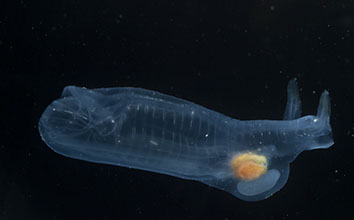Salps: The Ocean Vacuum Cleaners

The open ocean is a desert-like environment with very little nutrients. In the open ocean single-celled plankton are much smaller than close to the coasts (most are smaller than 2 micron, which is 50 times smaller than the smallest notch on your ruler!) and zooplankton struggle to get enough food to survive. But the ocean vacuum-cleaner, the Salp, has a strategy that few can beat. This large barrel-shaped gelatinous zooplankton combines swimming with its eating. It uses the same muscle-pumping to move water through its body to catch food while moving through the water! When it pumps water through its body it filters out all of the tiny plankton to eat. Usually the one part of the salp body you can see very clearly is its stomach. Imagine that your vacuum cleaner was all made of glass and the one thing you could see was the bag full of dust. That’s a bit like what a Salp is in the water. Salps can also form large blooms by growing really fast. They grow very fast because they are mostly water and they bud off of their parents. When this happens, they can leave the water crystal clear, as they clear all the particles out of it as they swim right through it! Next time you’re wondering who can clean your swimming pool, consider hiring the next salp bloom coming through town. The only problem might be their poop, which you can read about in the next chapter.
This portion of our website is specifically designed as outreach to the general public. If you are a scientist look for details about our research, please click on the red 'For Scientists' link on the top right.
Contact: Mike Stukel (mstukel@fsu.edu)
Florida State University
Dept. of Earth, Ocean, and Atmospheric Science
Center for Ocean-Atmospheric Prediction Studies




